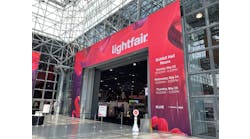With today’s emphasis on efficiency and longevity, light emitting diode (LED) lighting has become the first choice for many new construction and renovation projects, and the source is now creating opportunities for what light can do beyond illumination. LEDs can be individually controllable for light output and also for correlated color temperature (CCT) and even chromaticity. The U.S. Department of Energy (DOE) predicts that connected lighting/controls will account for one-third of all LED energy savings by 2035, and the use of controls in commercial buildings will dramatically increase during this same period. On the eve of Lightfair International, to be held in Philadelphia from May 7-11, let’s look at what’s on the horizon in the lighting industry, starting with light sources.
Manufacturers continue to raise lumen output and efficacy (lumens per Watt) at a healthy clip (e.g., 7% to 15%). They are also squeezing more light sources in an area than standard LED surface-mounted devices (SMDs) to achieve a high luminous density. Some manufacturers are offering spectra-tunable and dimmable horticultural LED fixtures to meet the specific growing needs of commercial greenhouses, research facilities, and universities, proving that specialized vertical markets can be well served by LED products.
While lighting systems and their controls can handle on/off operations, change color and color temperature, and even help in collecting ambient data, the big step in tying lighting systems, sensors, and other devices to building networks and linking them to the Internet is the role of the Internet of Things (IoT) industry. IoT is the growing global network of physical objects, or things, embedded with electronics, software, sensors, and connectivity to collect and exchange data in a local area network (LAN) or a larger network. It seemed infeasible only a few years ago, but pervasive connectivity — and the fact that there seems to be an app for almost everything — is transforming even industries such as healthcare, where lighting systems play a major role in improving patient well-being and speeding up healing time.
An IoT system can use either a centralized network architecture in which all connected devices deliver information to a central location, or a decentralized approach can be used, in which edge computing is done using embedded processors in the connected devices and the gateways. This approach provides faster processing and only a limited amount of data is sent back to a central data storage facility.
Unfortunately, the lack of interoperability between different systems is preventing LED lighting from gaining ground in the IoT sphere. A recent effort on getting such networks to operate together is an emerging standard called Thread, under development by a San Ramon, Calif.-based consortium called the Thread Group. Intended initially for residential applications, Thread is an IPv6-based open-source networking protocol communicating on a local wireless mesh network.
High-performance, structured network cabling systems within a building are ideal for supporting IoT needs, since data cables can handle both the digital information flow while also delivering DC power to devices connected to the cabling. Power over Ethernet (PoE) continues to stand out as the most widely used method for providing the DC low-voltage distribution system to a structured wiring system serving a data network. Structured cabling standards define a 100 m length for cabling from an equipment room to the served device. Global revenue for PoE lighting is expected to grow from an estimated $35.8 million in 2016 to $419.9 million in 2025, according to a recently released report from Navigant Research.
A recent development in the PoE market is the use of a zoned cabling system. An Ethernet data switch installed in the ceiling plenum — close to the luminaires, HVAC, security, or other functions being served — reduces DC power losses in the powered cables.
In addition to PoE, powered wired systems also include the Emerge Alliance standard and a variety of proprietary cabling systems, which includes a plenum-mounted centralized power conversion chassis for efficiency and a DC cabling system. Wireless communications solutions such as Bluetooth, Wi-Fi, Li-Fi, ZigBee, Z-Wave, Narrow Band IoT, and proprietary wireless systems are also used.
Finally, major lighting companies continue to look at IoT in conjunction with startup companies, while also partnering with firms offering cloud computing capabilities.
LED light source performance enhancements over the past few years are projected to lead to better luminaires, not just legacy luminaires outfitted with the LED source. Industry associations, such as Lighting for Tomorrow, the Design Lights Consortium, and Energy Star, continue to offer information regarding the newest lighting products that meet specific performance guidelines. Someday, perhaps, luminaires will be called digital devices able to handle data, while also providing illumination. We are ushering in an unprecedented union between lighting and other building services, and possibly initiating what may become a trend: shifting from selling lighting systems to selling services that link luminaires with data.
SIDEBAR 1: Light and Health
While researchers probe for a deeper understanding of the link between light and health, lighting designers and allied professionals are gaining a better understanding of basic circadian lighting design principles. Our eyes have non-visual photoreceptors that are key in helping to regulate our biological clock — our circadian rhythm — and the production of neurochemicals linked to sleep, mood, and our immune system.
A human-centric lighting system, using color-tunable fixtures or those that can change color gradually through the day, can improve the performance and well-being of occupants by assisting in the maintenance of body temperature, hormone production, cell regeneration, and brain wave activity. Although the lighting industry has not been able to directly specify wellness lighting products to achieve health benefits, research continues on determining the optimum quantity, spectrum, timing, and duration of light exposure. What we know is that LED lighting technology can be tailored to specific content, design, and layout to effectively meet specific biological needs.
The positive effect of LED lighting on Alzheimer’s disease and related dementias, such as Attention Deficit/Hyperactivity Disorder (ADHD), Autism Spectrum Disorder (ASD) and Sensory Processing Disorder (SPD) continues to be studied by health care counselors.
SIDEBAR 2: Area and Roadway Lighting Trends
The directional output, durability, and longevity of LEDs have given this light source a 21% share of the installed base in roadway lighting, with a prediction that LEDs will gain an even larger share in the future. Pairing networked controls with occupancy sensors, other ambient sensors, and dimmable sources allows a roadway lighting system to adapt to changes in the environment (light levels). Many systems use a wireless mesh network to place the luminaires into a larger network. Video cameras are even being installed on streetlight poles to record both high-resolution and low-resolution images, and maintain video storage in the field rather than at a centralized location.




